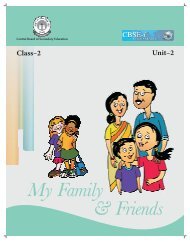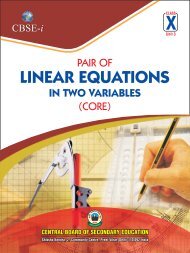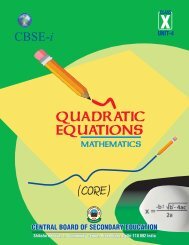CBSEi Class 10 Sequences (AP and GP) CORE
CBSEi Class 10 Sequences (AP and GP) CORE
CBSEi Class 10 Sequences (AP and GP) CORE
You also want an ePaper? Increase the reach of your titles
YUMPU automatically turns print PDFs into web optimized ePapers that Google loves.
(vi) Area of fourth square =<br />
Similarly, area of fifth square = <strong>and</strong> area of 6 th square = <strong>and</strong> so on.<br />
Area of the nth square = , where n is a natural number.<br />
(vii) Next number in the pattern =<br />
Similarly, next to this number = <strong>and</strong> so on.<br />
Clearly, the nth number = where n is a natural number.<br />
(viii) Observing the pattern, the next number = 9 x 48 [Next number of 1, 3, 5, 7 is 9<br />
(Why?) <strong>and</strong> that of 3 , 6, 12, 24 is 48 (Why?)]<br />
(ix) Here, we see that<br />
1 st number = 1<br />
2 nd number = 1<br />
3 rd number = 1+1=2<br />
4 th number = 1+2=3<br />
5 th number = 2+3=5<br />
6 th number = 3+5=8<br />
7 th number = 5+8=13<br />
8 th number = 8+13=21<br />
9 th number = 13+21=34<br />
<strong>10</strong> th number = 21+34 = 55 <strong>and</strong> so on.<br />
Here, every number, except the first two numbers, is the sum of preceding<br />
two numbers.<br />
This pattern is known as Fibonacci Sequence, named after a great Italian<br />
mathematician Leonardo Fibonacci (1170-1250).<br />
(x) Here, 1 st number =<br />
39

















